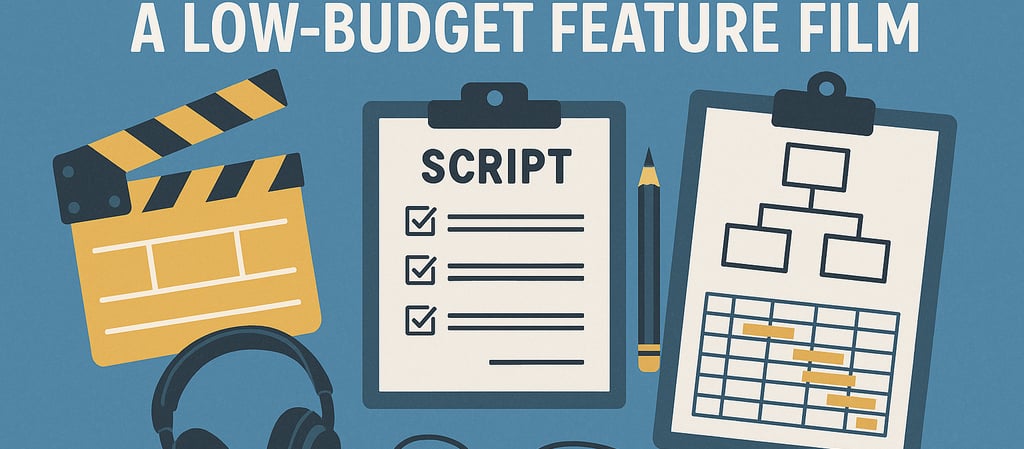Pre-Production Steps for a Feature Film
Here's a step-by-step pre-production guide tailored specifically for a low-budget feature film, balancing creative ambition with practical constraints.
Rahul Verma
7/22/20253 min read


Pre-production is the foundation of any successful film, and for a low-budget feature, it’s where creative problem-solving meets logistical planning. This stage involves transforming your screenplay into a tangible, shoot-ready blueprint, minimizing risks and maximizing resources.
The process begins with locking the script—refining it to suit budget constraints by limiting locations, characters, and complex scenes. A script breakdown follows, identifying all production elements like props, costumes, and cast, which helps build a detailed, realistic budget. Tools like StudioBinder or Gorilla Budgeting are invaluable for organizing schedules and expenses.
1. Finalize Your Script
Lock the screenplay before moving forward. Minimize expensive elements (e.g. multiple locations, large cast, night shoots, VFX).
Run a table read with actors or peers for feedback.
Use tools: Final Draft, Arc Studio, or Celtx for formatting.
2. Create a Realistic Budget
Break down your script scene-by-scene (via script breakdown).
Use Movie Magic Budgeting, Gorilla Budgeting, or Google Sheets.
Categorize: cast, crew, equipment, locations, production design, food, transport, post-production, contingency (~10%).
3. Develop a Production Plan
Use StudioBinder, SetHero, or Notion to plan and organize.
Draft a rough shooting schedule (number of shoot days, weekend availability, etc.).
Identify high-risk scenes (crowds, stunts, complex locations).
4. Assemble Your Core Team
Prioritize multi-skilled crew (e.g. a DP who can also operate camera or a 1st AD who can help schedule).
Minimum core crew: Director, Producer, DP, Sound Mixer, AD, Gaffer, Editor.
For ultra-low budgets: you may combine roles or use film students/early-career professionals.
5. Location Scouting & Permits
Choose free/owned locations when possible.
Secure permissions early and consider location sound quality.
Tools: Google Maps, ShotDeck, Sun Seeker (for lighting planning).
6. Casting
Cast actors based on talent, reliability, and chemistry.
Host self-tapes or local auditions in minimal-cost locations.
Use non-union actors or SAG Ultra Low Budget Agreements.
7. Script Breakdown & Scheduling
Identify all elements in each scene: props, costumes, cast, vehicles, FX, etc.
Build a stripboard (physical or via software like StudioBinder).
Finalize your day-out-of-days (DOOD) reports.
8. Gear & Equipment Planning
Rent only essential gear. Partner with film schools or local production companies.
Package deals from rental houses are cheaper than à la carte.
Choose gear that’s lightweight and power-efficient for fast setups.
9. Shot Listing & Storyboarding
Prioritize efficiency in coverage (e.g. master shot + inserts).
Use Shot Designer or FrameForge for pre-vis.
Simple storyboards (even hand-drawn) help align with your DP and team.
10. Production Design & Wardrobe
Think minimalism and reuse.
Use real locations and pre-owned or thrifted costumes/props.
Art direction can carry aesthetic even with minimal budget if stylized right.
11. Insurance, Legal & Paperwork
Secure production insurance (short-term or annual).
Get location agreements, talent releases, and crew contracts.
Templates: Use online repositories (I can provide some if you like).
12. Create a Lookbook / Moodboard / Director’s Vision Doc
Convey tone, style, and visual palette.
Helps crew align and can be used to pitch to partners/funders.
Use Milanote or Canva for easy layout.
13. Logistics & Call Sheets
Plan transport, food, power needs (batteries/generators), backups.
Build call sheets with StudioBinder or a simple template.
Consider weather, sunlight, and local events that might affect shooting.
14. Rehearsals & Tech Scout
Block key scenes with actors before shoot.
Do a tech scout with key crew at locations: assess power, space, light, sound.
15. Finalize Shooting Schedule
Lock dates.
Send out call sheets, shot lists, and a schedule to all cast & crew.
Always build buffer time and a backup day if possible.
Other key tasks include planning wardrobe and set design, securing insurance, drafting legal documents, and preparing call sheets. Tools like Milanote or Canva can help visualize your film’s aesthetic through mood boards or a lookbook.
Finally, rehearsals and technical scouts allow the team to troubleshoot before the cameras roll. A well-structured production schedule—with built-in buffer time—ensures smoother shoot days. With thorough pre-production, even a low-budget film can achieve high production value and strong storytelling.
